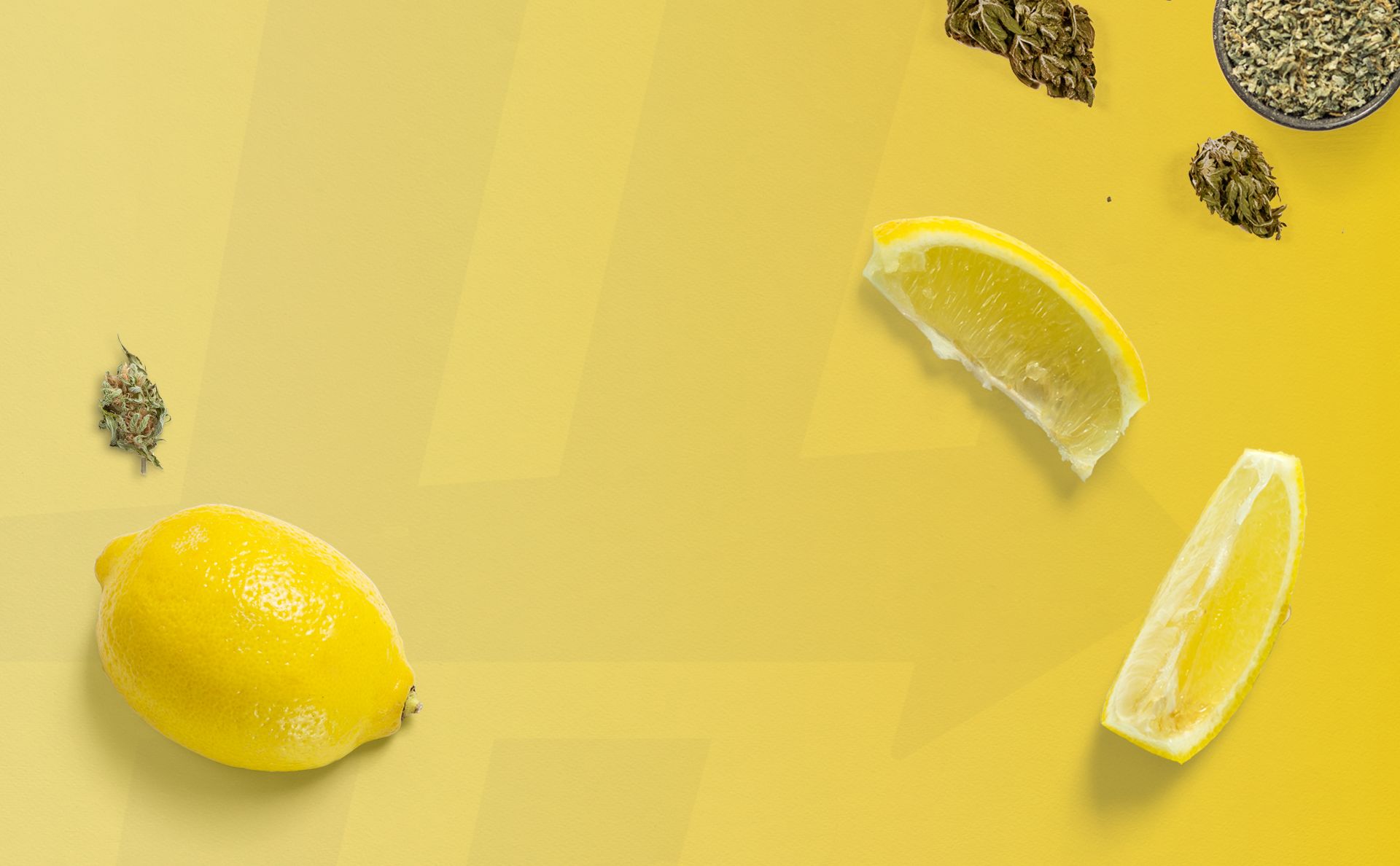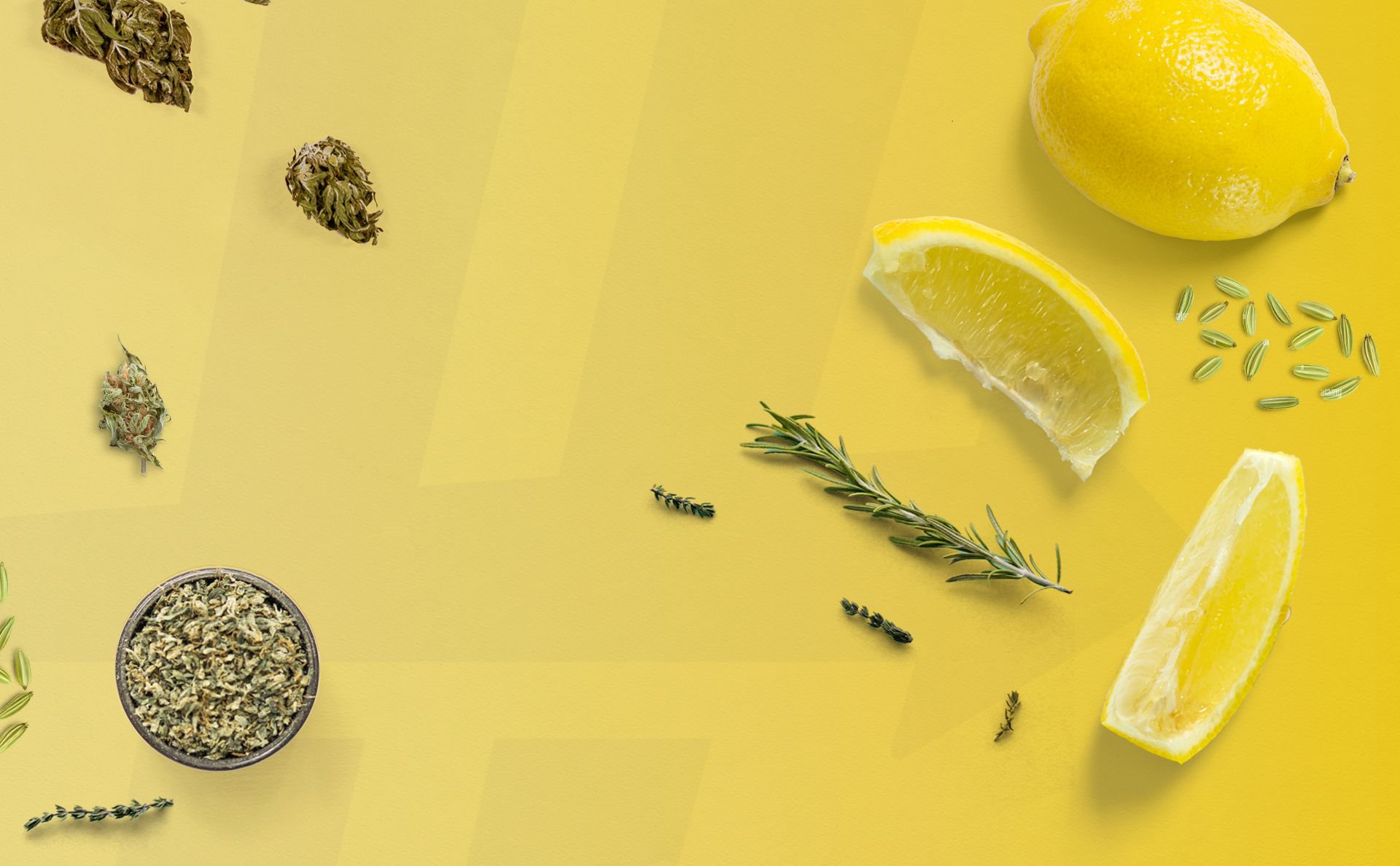Limonene
Found in most citrus fruits, the flavorful terpene limonene is also present in many delicious cannabis strains. Here, we’ll explore the aroma and taste of limonene, along with its potential medical benefits and practical applications beyond cannabis.

In this chapter, we discuss the terpene known as limonene. One of the most pleasant-smelling terpenes, limonene also has some potential benefits. Read on for more.
What is Limonene?
Pronounced “li-muh-neen,” limonene is the second most common terpene found in cannabis, just behind myrcene. In addition to cannabis, limonene is found in flowers, lilacs, and most especially in citrus fruits like lemons, limes, oranges, guava, and juniper.
Limonene is made by plants primarily as an insect repellent and parasite defense agent (e.g., antimalarial). For humans, limonene may hold a wide variety of interesting potential benefits. We’ll discuss these later on.
Limonene gives plants their natural lemon scents, so this terpene is commonly used in household cleaning products due to its pleasant smell. Keep in mind that naturally-occurring amounts of limonene in plants like cannabis are safe to consume, but it is not safe to consume undiluted, concentrated, or synthetic sources of terpenes like detergents, soaps, and household cleaners.
Terpene Flavor and Aroma Profile: Limonene
Limonene is one of the most recognizable of all the terpenes, mainly because of its indistinguishable zesty scent that can be found in many citrus fruits and tons of food and beverage products. The most abundant amount of limonene is typically found in lemons. However, terpinolene also gives off citrusy aromas in cannabis varieties, so it’s not necessarily just limonene.
If you’ve enjoyed sweet treats like lemon baked goods, sour lemon candy, chocolate-covered orange peels, and sherbet ice cream, then your taste buds have experienced high-intensity limonene. Naturally, real lemonade also contains a good amount of limonene. Thanks to its pleasant scent, limonene is found in many balms, massage oils, and even in many household cleaning products.

Limonene lends its scent to many plants in our natural world - including pine, juniper, mint, fennel, and rosemary. Rosemary is often found in massage oils and essential oils for aromatherapy. For industrial purposes, limonene is used as a solvent that helps remove excess oil from heavy machinery, strip paint, and act as an herbicide that is both effective and organic.
For many centuries of alternative medicine, limonene has been used in traditional Chinese medicine, Ayurveda, and folk remedies to help with ailments like painful and swollen wounds, oral cavities, digestive problems, abdominal pain, worms, and colds. Additionally, limonene has been used for many years thanks to its antiseptic and antimicrobial properties.

What the expert says...
Dr. Abraham Benavides
"Known as the citrus terpene, limonene is the second most abundant terpene and can be found in many foods, desserts, drinks, and household cleaning products thanks to its natural antibacterial properties and pleasant lemon-like scent."
Cultivars with Limonene
Limonene is one of the top 5 most common terpenes in cannabis, so you won’t have any trouble finding it. Some of the most common cultivars containing limonene include:
- Lemon Haze
- Lemon G
- Animal cookies and the cookie lineage
- Do-Si-Dos
- White Fire OG
- Sour Diesel
- Bruce Banner
- Marionberry Kush
Does Limonene Get You High?
Recent 2023 preclinical evidence suggests that several terpenes, including limonene, may activate the CB1 receptor with 10 to 50% of the strength of THC. The results also suggest that limonene and other terpenes may synergize with THC at the CB1 receptor to increase its effects. This is untested in people, so we don’t know for sure yet how much limonene it may take to get high, or if it actually does.
These results are in contrast to all previous studies showing terpenes as nonpsychotropic, so it's still under investigation. If confirmed, this new synergy at the psychotropic CB1 receptor lends more support to the entourage effect.
Meanwhile, we know limonene already contributes to the entourage effect by boosting levels of serotonin and dopamine. This induces antianxiety, anti-stress, and antidepressant effects.
Potential Benefits of Limonene
Limonene is one of the most potentially beneficial and abundant terpenes in existence. Based on preclinical and few, small clinical studies, the possible benefits and uses of this citrus-scented terpene include:
- Pain relief
- Anti-anxiety and anti-stress
- Antidepressant
- Anti-inflammatory and antioxidant
- Anti-asthmatic
- Gastroprotective
- Heartburn and GERD relief
- Anti-cancer activity against breast, bladder, colon, lung, and skin cancers in vitro
- Anti-osteoarthritic
- Anti-obesity and antihyperlipidemic
- Blood sugar regulating
- Antibacterial and anti-acne
- Synergy with gentamicin in MRSA
- Antifungal
Natural amounts of limonene found in food and cannabis are well-tolerated and generally recognized as safe (GRAS) by the FDA. However, if you take concentrated or isolated forms of limonene, such as those in cleaners, you may have side effects such as skin irritation, irritation, and other potentially serious side effects depending on the dose and concentration.
What We Learned: Limonene
Limonene is one of the most common, valuable, and beneficial terpenes found in cannabis and our natural world. Next time you eat any kind of citrus, we have a feeling you'll be thinking of limonene. Here’s what we learned about limonene in this chapter:
- In addition to cannabis, limonene is found in citrus fruits, flowers, and lilacs.
- Limonene is naturally lemon-scented, so this terpene can be easily identified in cultivars and found in foods, sweets, beverages, and household cleaning products due to its pleasant smell.
- Some of the most common cultivars containing limonene include Lemon Haze, Lemon G, Cookies lineages, and White Fire OG.
- Limonene has a myriad of potential benefits, including pain-relieving, anti-inflammatory, anticancer, antibacterial, antianxiety, and antidepressant properties, as well as potentially helping with metabolic complications of obesity like high blood cholesterol and sugars.
More research will also likely find more benefits from plants that contain terpenes like limonene, not just cannabis. The future of the wonderful world of terpenes is here, and HashDash is your educational resource for these invaluable compounds.
Speaking of educational resources, the next chapter in our terpenes guide is waiting for you, right after you answer the below question correctly.
Citations
- Al-Khazaleh, A. K., Zhou, X., Bhuyan, D. J., Münch, G. W., Al-Dalabeeh, E. A., Jaye, K., & Chang, D. (2024). The Neurotherapeutic Arsenal in Cannabis sativa: Insights into Anti-Neuroinflammatory and Neuroprotective Activity and Potential Entourage Effectshttps://doi.org/10.3390/molecules29020410
- Benavides, A. (2022, May 9). Limonene—Terpenes and Cannabinoid Research. Cannakeys.https://cannakeys.com/limonene-terpene-research/
- Cox-Georgian, D., Ramadoss, N., Dona, C., & Basu, C. (2019). Therapeutic and Medicinal Uses of Terpenes. Medicinal Plants, 333–359.https://doi.org/10.1007/978-3-030-31269-5_15
- de Cássia da Silveira e Sá, R., Lima, T. C., da Nóbrega, F. R., de Brito, A. E. M., & de Sousa, D. P. (2017). Analgesic-Like Activity of Essential Oil Constituents: An Update. International Journal of Molecular Sciences, 18(12), 2392.https://doi.org/10.3390/ijms18122392
- Jing, L., Zhang, Y., Fan, S., Gu, M., Guan, Y., Lu, X., Huang, C., & Zhou, Z. (2013). Preventive and ameliorating effects of citrus D-limonene on dyslipidemia and hyperglycemia in mice with high-fat diet-induced obesity. European Journal of Pharmacology, https://doi.org/10.1016/j.ejphar.2013.06.022
- Liktor-Busa, E., Keresztes, A., LaVigne, J., Streicher, J. M., & Largent-Milnes, T. M. (2021). Analgesic Potential of Terpenes Derived from Cannabis sativa. Pharmacological Reviews, 73(4), 1269–1297.https://doi.org/10.1124/pharmrev.120.000046
- Raz, N., Eyal, A. M., Zeitouni, D. B., Hen-Shoval, D., Davidson, E. M., Danieli, A., Tauber, M., & Ben-Chaim, Y. (2023). Selected cannabis terpenes synergize with THC to produce increased CB1 receptor activation. Biochemical Pharmacology, 212, 115548.https://doi.org/10.1016/j.bcp.2023.115548
- Russo, E. B. (2011). Taming THC: Potential cannabis synergy and phytocannabinoid-terpenoid entourage effects. British Journal of Pharmacology, 163(7), 1344–1364.https://doi.org/10.1111/j.1476-5381.2011.01238.x
- Siracusa, L., Ruberto, G., & Cristino, L. (2023). Recent Research on Cannabis sativa L.: Phytochemistry, New Matrices, Cultivation Techniques, and Recent Updates on Its Brain-Related Effects (2018–2023). Molecules, 28(8), 3387.https://doi.org/10.3390/molecules28083387
- Sommano, S. R., Chittasupho, C., Ruksiriwanich, W., & Jantrawut, P. (2020). The Cannabis Terpenes. Molecules, 25(24), 5792.https://doi.org/10.3390/molecules25245792
- Surendran, S., Qassadi, F., Surendran, G., Lilley, D., & Heinrich, M. (2021). Myrcene—What Are the Potential Health Benefits of This Flavouring and Aroma Agent? Frontiers in Nutrition, 8.https://doi.org/10.3389/fnut.2021.699666
- Tomko, A. M., Whynot, E. G., Ellis, L. D., & Dupré, D. J. (2020). Anti-Cancer Potential of Cannabinoids, Terpenes, and Flavonoids Present in Cannabis. Cancers, 12(7).https://doi.org/10.3390/cancers12071985
- Wróblewska-Łuczka, P., Cabaj, J., Bargieł, J., & Łuszczki, J. J. (2023). Anticancer effect of terpenes: Focus on malignant melanoma. Pharmacological Reports, 75(5), 1115–1125.https://doi.org/10.1007/s43440-023-00512-1
Test your knowledge, track your progress and earn your badge.
Limonene is the most common terpene found in cannabis?

Dr. Abraham Benavides
Dr. Abraham Benavides is an internationally-recognized cannabis research expert, experienced medical advisor, and full-tuition merit scholar of the George Washington University School of Medicine and Health Sciences. Dr. Abe enjoys helping patients as a writer, educator, and cannabis health coach at the GW Center for Integrative Medicine.